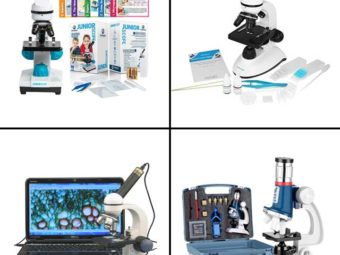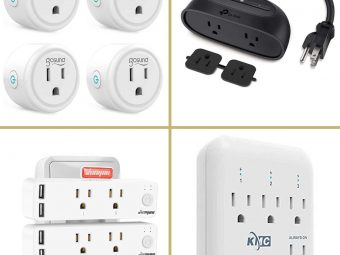
Image: Shutterstock
Breast changes during pregnancy may come as a shock to you, but it’s an important change during this phase. These changes in your breasts assist your body in preparing to feed your baby.
If you had small, perky breasts before pregnancy, you might notice that the size of your breasts has increased. You may also notice a few stretch marks on your breasts. In addition, you may observe that your breast veins have become prominent, and your breasts leak as your pregnancy advances.
Continue reading to know more about the changes in a pregnant woman’s breasts, how and why these changes occur during pregnancy, and how to alleviate any discomfort.
Why Do Breast Changes Happen During Pregnancy?
Hormone changes in pregnancy trigger higher blood flow to your breasts, and modify the breast tissue. This will make your breasts sore, swollen, sensitive, and tingly (1). It might give a similar intense sensation that some women experience just before their period.
What Kind Of Breast Changes Occur In Each Trimester?
Breast changes during early pregnancy are unusual as they prepare for their unique role of nourishing the newborn. Below, we list out the breast changes that you could experience in each trimester of your pregnancy.
First trimester:
In your first trimester, i.e., weeks one to 12, you will feel your breasts have swollen and are tender. Nipples start to stick out more than normal, and you can feel a tingling sensation. You may also notice them getting bigger during this time.
Weeks one to three:
The alveolar buds and milk ducts during pregnancy grow rapidly. In the second week, breast changes peak as the fertilized egg implants in the uterus at the late luteal phase of the cycle. Soon after conception, you can experience some tenderness in your breasts. They are more sensitive towards the sides as the internal mammary artery is located there. (2).
Weeks four to six:
Once the fourth week begins, you will experience prickling and tingling sensation around the nipples which may be due to the increase in the blood supply. Sometimes, tingling may also be accompanied by fluctuation in temperatures. Around the sixth week, the nipples turn more prominent, and areolas get darker due to increasing pigmentation. Your breasts become fuller because of the estrogen, progesterone, and placental lactogen. You will notice the milk ducts to swell as they prepare for lactation.
Weeks seven to nine:
In the seventh week, you are likely to gain weight. Each breast may increase by one and a half pounds as pregnancy hormones stimulate the growth of milk ducts and encourage accumulation of fat. Around the seventh week, the alveoli expand at a significant rate and transform into lobules. Come week eight and your breasts will get tender, sore, and nodular, and you can observe blood vessels beneath the skin. Small pimples called Montgomery’s tubercles form around the nipples. By week nine, the areolas get darker with a second round forming around the light colored tissue. The inverted nipples correct themselves and point outward.
Weeks ten to 12:
The pimples around the nipples become prominent. The breast tenderness increases. If it is your first pregnancy, then the nipples protrude completely by the 12th week. Those with cosmetic breast implants feel more tender around this week.
Colostrum can be squeezed out of the breast at 12th week.
Second trimester:
During the second trimester, i.e., weeks 13 to 27, your breasts continue to grow heavier and larger. Your breast size during pregnancy increases by at least one or probably two cup sizes. You will have less tenderness and tingling sensation compared to the earlier weeks.
The veins become apparent beneath the skin. The areola and nipples become larger and darker. You may even notice small bumps on the areola, and they will disappear after your delivery. The stretch marks on your breasts also become visible. (3).
Around week 16 to 19, your nipples start discharging a thick and yellowish fluid known as colostrum. This shows your breasts are preparing for breastfeeding. It is the pre-milk, which protects your baby from any infections in the initial days of nursing.
The demonstration of secretion from the breasts of a woman, who has never lactated is a important sign of pregnancy.
Third trimester:
Your breasts will grow more, and you will feel heavier. You may have to get a supportive maternity bra or a larger bra.
Sometimes, colostrum may leak now than at any previous stage of pregnancy.
When Should You Seek Medical Help?
It is normal for the breasts to undergo many changes during pregnancy and narrowing them down to a certain medical condition might be tricky. But there is a possibility of developing breast cancer or tumor around this time. If you notice any lumps in your breasts, see a doctor and go for a complete medical examination.
What Can You Do To Ease Breast Pain And Discomfort?
You can take the following measures to reduce breast discomfort during pregnancy:
For sore and tender breasts:
- During the day, wear a bra which supports your back and sides well. You can also use padded shoulder straps and bras made of cotton to stay more comfortable.
- During night, use a sleep bra. They are lighter and soft and offer support when you sleep.
- Do not wash the nipple region with soap as it will dry out the skin. Just use warm water to clean the area.
For itchy skin:
- Do not take hot shower baths.
- Post bathing, pat dry the breast area with a clean washcloth and apply a moisturizer. Do not allow the region to dry. You may feel better if you use a refrigerated moisturizer.
- Do not use skin products containing alcohol, drying soaps, and chlorinated water as they dry your skin.
- Use a humidifier at home if the environment is dry.
- If the itching is too severe, check with your doctor.
For breasts leaking colostrums:
- Use washable or disposable breast pads to soak up the leakage.
- Soon after the shower, allow your breasts to air dry for some time.
Choosing the right bra:
- Choose a bra whose cups cover your breasts completely.
- Ensure the shoulder straps are adjustable.
- The straps need to fit well and should not slide off.
- The bra should have a thickened flat strap at the bottom so that it provides better support to the breasts and the back.
Frequently Asked Questions
1. Do breasts go back to their normal size after pregnancy?
According to the NCT, “breasts may be larger during the first few months of breastfeeding, but most return to pre-pregnancy size after breastfeeding stops (4).”
2. Does massaging the breasts help relieve breast pain?
Changes in your breasts occur throughout the pregnancy as they prepare to nourish the newborn. Major changes might not be visible during the first trimester, but you can feel your breasts becoming heavy as the second trimester progresses. Therefore, it is advisable to wear supportive maternity bras to feel comfortable while you sleep or work. In addition, since the chances of breast cancer during pregnancy is higher, doctors advise you to regularly self examine your breasts and consult the doctor if you feel any lumps.
References
- Breast Changes During Pregnancy.
https://americanpregnancy.org/healthy-pregnancy/changes-in-your-body/breast-changes-during-pregnancy/ - What are some common signs of pregnancy?
https://www.nichd.nih.gov/health/topics/pregnancy/conditioninfo/signs - Changes in Your Body During Pregnancy: Second Trimester.
https://familydoctor.org/changes-in-your-body-during-pregnancy-second-trimester/ - What will happen to your breasts after birth?.
https://www.nct.org.uk/labour-birth/you-after-birth/what-will-happen-your-breasts-after-birth - Loretta Anderson et al.; (2019); Effectiveness of breast massage for the treatment of women with breastfeeding problems: a systematic review
https://pubmed.ncbi.nlm.nih.gov/31135656/ - Breastfeeding FAQs: Pain and Discomfort.
https://kidshealth.org/en/parents/breastfeed-discomfort.html














